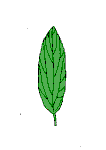|
Viburnum leaf
beetle home
Guide to identifying Viburnums
Common
names
Is
it a viburnum?
Which
viburnum?
Express key
ID
tutorial
Guide to viburnums by David Swaciak.
Leaf drawings by
Marcia Eames-Sheavly.
Logo
images by Paul Weston & Craig Cramer
|
|
Leaves:
- Evergreen
- 1.5 to 2 inches long, .25 to 1.25 inches wide
- Margin (edge) entire (smooth)
- Underside pale blue-green with dense stellate pubescence (star-like hairs), glabrous
(smooth) on top
|

Click for larger image. |
Flowers:
- Pink buds open to creamy white flowers in 2 to 2.5 inch
flat-topped clusters
Fruits:
- Change from red to black in August
|
|
More information:
- Grows about 5 feet tall with an equal or greater spread.
- Hardy to Zone 6, but performs better in Zones 7 and 8.
- Evergreen and heat tolerant in the southern U.S.
- Resistant to bacterial leaf spot.
- May not set fruit as they require cross-pollination from viburnums with different parents.
- Viburnum utile 'Conoy' bush
- Viburnum utile 'Conoy' flower buds
Similar
Species and distinguishing characteristics:
Viburnum
cassinoides
Leaves deciduous, 1.5 to 3.5 inches long, .75 to 2.25 inches wide. Rounded teeth along margin.
|
|
Viburnum
x burkwoodii
Leaves 1.5 to 4 inches long, .75 to 1.75 inches wide. Margin
entire (smooth) but usually with small irregular teeth. |
|
Back to beginning Which viburnum is it?
© Copyright, Department of Horticulture, Cornell University.
Project coordinator: Lori Brewer, ljb7@cornell.edu
Website design: Craig Cramer cdc25@cornell.edu
Mention of trade names and commercial products is for educational
purposes; no discrimination is intended and no endorsement by Cornell
Cooperative Extension or Cornell University is implied. Pesticide
recommendations are for informational purposes only and manufacturers'
recommendations change. Read the manufacturers' instructions carefully
before use. Cornell Cooperative Extension and Cornell University assumes
no responsibility for the use of any pesticide or chemicals. Some
of the links provided are not maintained by Cornell Cooperative Extension
and Cornell University. Cornell Cooperative Extension and Cornell
University are not responsible for information on these websites.
They are included for information purposes only and no endorsement
by Cornell Cooperative Extension or Cornell University is implied.
Cornell Cooperative Extension provides equal program and employment
opportunities. |